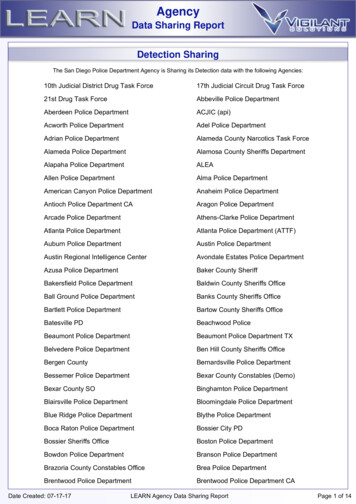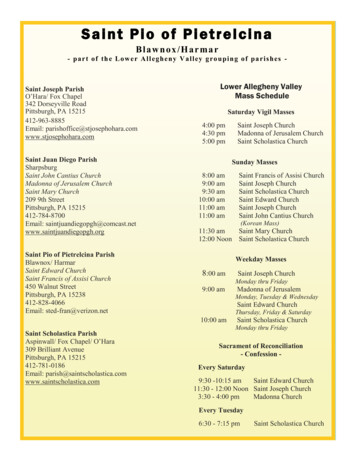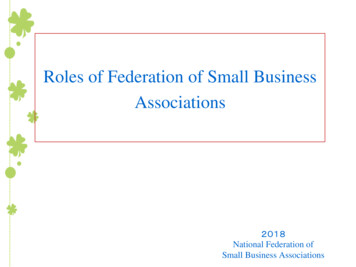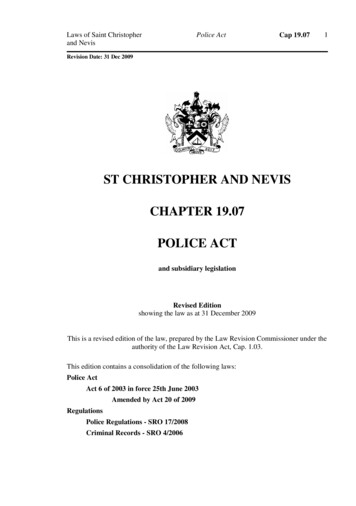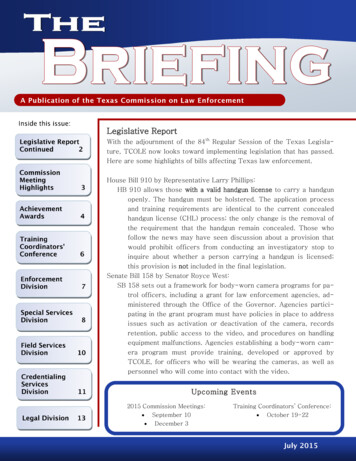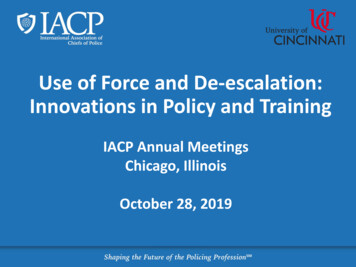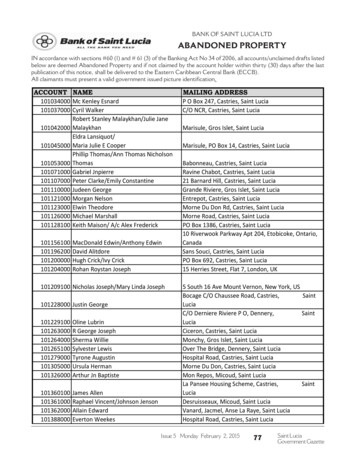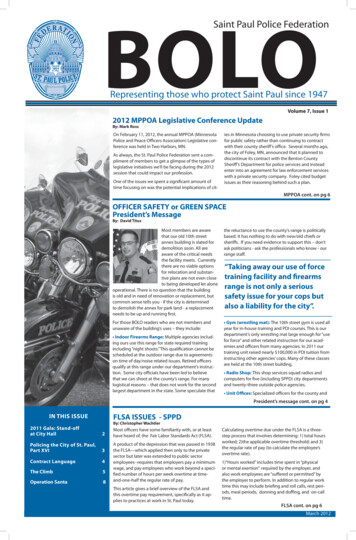
Transcription
BoloSaint Paul Police FederationRepresenting those who protect Saint Paul since 1947Volume 7, Issue 12012 MPPOA Legislative Conference UpdateBy: Mark RossOn February 11, 2012, the annual MPPOA (MinnesotaPolice and Peace Officers Association) Legislative conference was held in Two Harbors, MN.As always, the St. Paul Police Federation sent a compliment of members to get a glimpse of the types oflegislative initiatives we’ll be facing during the 2012session that could impact our profession.One of the issues we spent a significant amount oftime focusing on was the potential implications of cit-ies in Minnesota choosing to use private security firmsfor public safety rather than continuing to contractwith their county sheriff’s office. Several months ago,the city of Foley, MN, announced that it planned todiscontinue its contract with the Benton CountySheriff’s Department for police services and insteadenter into an agreement for law enforcement serviceswith a private security company. Foley cited budgetissues as their reasoning behind such a plan.MPPOA cont. on pg 6OFFICER SAFETY or GREEN SPACEPresident’s MessageBy: David TitusMost members are awarethat our old 10th streetannex building is slated fordemolition soon. All areaware of the critical needsthe facility meets. Currentlythere are no viable optionsfor relocation and substantive plans are not even closeto being developed let aloneoperational. There is no question that the buildingis old and in need of renovation or replacement, butcommon sense tells you - if the city is determinedto demolish the annex for park land - a replacementneeds to be up and running first.the reluctance to use the county’s range is politicallybased. It has nothing to do with new/old chiefs orsheriffs. If you need evidence to support this – don’task politicians - ask the professionals who know - ourrange staff.For those BOLO readers who are not members andunaware of the building’s uses – they include: Gym (wrestling mat): The 10th street gym is used allyear for in-house training and PDI courses. This is ourdepartment’s only wrestling mat large enough for “usefor force” and other related instruction for our academies and officers from many agencies. In 2011 ourtraining unit raised nearly 100,000 in PDI tuition frominstructing other agencies’ cops. Many of these classesare held at the 10th street building. Indoor Firearms Range: Multiple agencies including ours use this range for state required trainingincluding “night shoots.” This qualification cannot bescheduled at the outdoor range due to agreementson time of day/noise related issues. Retired officersqualify at this range under our department’s instruction. Some city officials have been led to believethat we can shoot at the county’s range. For manylogistical reasons – that does not work for the secondlargest department in the state. Some speculate that“Taking away our use of forcetraining facility and firearmsrange is not only a serioussafety issue for your cops butalso a liability for the city”. Radio Shop: This shop services squad radios andcomputers for five (including SPPD) city departmentsand twenty-three outside police agencies. Unit Offices: Specialized officers for the county andPresident’s message cont. on pg 4FLSA ISSUES - SPPDIn This IssueBy: Christopher Wachtler2011 Gala: Stand-offat City Hall2Policing the City of St. Paul,Part XVI3Contract Language4The Climb5Operation Santa8Most officers have some familiarity with, or at leasthave heard of, the Fair Labor Standards Act (FLSA).A product of the depression that was passed in 1938the FLSA—which applied then only to the privatesector but later was extended to public sectoremployees--requires that employers pay a minimumwage, and pay employees who work beyond a specified number of hours per week overtime at timeand-one-half the regular rate of pay.This article gives a brief overview of the FLSA andthis overtime pay requirement, specifically as it applies to practices at work in St. Paul today.Calculating overtime due under the FLSA is a threestep process that involves determining: 1) total hoursworked; 2)the applicable overtime threshold; and 3)the regular rate of pay (to calculate the employee’sovertime rate).1)“Hours worked” includes time spent in “physicalor mental exertion” required by the employer, andalso work employees are “suffered or permitted” bythe employer to perform. In addition to regular worktime this may include briefing and roll calls, rest periods, meal periods, donning and doffing, and on-calltime.FLSA cont. on pg 6March 2012
2011 GALA: STAND-OFF AT CITY HALL!!By: Rob SchultzWhen trouble strikes, the SPPD S.W.A.T. Team isthere. That was evident at the 7th Annual St. PaulPolice Foundation Gala, where attendees experienced a simulation of the S.W.A.T. Team responding to a mock hostage crisis at City Hall.Under the narration of Commander Tim Flynn, acolorful cast of familiar talent posed as captives tobe rescued: Ramsey County Attorney John Choi,City Council President Kathy Lantry, and SPPDChief Tom Smith. Making a grand entrance, members of the S.W.A.T. Team stormed the banquet halland saved Saint Paul.The evening was filled with many other memorable moments as well: the VIP Reception hostedby Chief Smith and sponsored by Mancini’s andCossetta’s; a bigger silent auction that featuredthe best of the Twin Cities; raffles for prizes thatincluded a trip to Las Vegas; and a photo booth bythe Ramsey County Sheriff’s Department.Minnesota Governor Mark Dayton welcomedattendees, and KARE-11’s Rena Sarigianopolousserved as Master of Ceremonies. Other programhighlights included the Minnesota Pipe Band andSaint Paul Police Honor Guard’s presentation ofcolors, Patricia Lacy singing the National Anthem,invocation by Father Dan Conlin, and remarks byCity Council President Kathy Lantry.This year’s Rowan Award recipient was Officer Michael Reuvers, known for his work in putting someof the most violent and persistent criminals in jailfor decades during his days in patrol and now as amember of the special investigations unit.With the help of Chief Smith, the Police Foundation hosted it’s second annual “Giving Moment”– this year’s proceeds benefits SPPD’s new “ProjectCARE” initiative a results-oriented program designed to protect children and senior citizens. Following an introductory video, attendees providedfinancial support for the department’s focus oncrimes against vulnerable children and seniors.To cap off a wonderful evening, participants enjoyed dancing to live music by the Tim Sigler Band.Funds from the Gala help operate the Police Foundation and its grant-making programs. This year’sGala will provide funding for Shop with Cops, Copsand Kids, and other new and upcoming projectsand grant initiatives.The St. Paul Police Foundation wishes to thankthe St. Paul Police Department and the St. PaulPolice Federation for helping to make this year’sGala a big success. Many officers and administrators worked hard to make this year’s event reflectthe interest and requests of our officers. A specialthanks goes outto Gala Co-ChairsNancy Haas andDave Titus for theirhard work, and toHelene Houle whoserved as HonoraryChair of the Gala.Chief Sponsors ofthe Gala were JohnNasseff & HeleneHoule; and Target. CommanderSponsers were 3MCorporate Security;Comcast; DowellStute & Associates;HealthPartners/Regions Hospital;Hubbard Broadcasting; The RowanFamily; Travelers; Visit Saint Paul; Warners’ Stellian.Sergeant Sponsors were: Avrio; Dacotah FurnitureCo.; Goff Public; Messerli & Kramer; O’Gara’s Bar& Grill; Ramsey County Sheriff’s Office; Saint PaulArea Chamber of Commerce; Securian; SpectacleShoppe.Officer Sponsors were: Advanced Auto Services;Allina Hospitals & Clinics; Anchor Bank; BRUNOLaw; Chestnut & Cambronne; Collins, Buckley,Sauntry & Hough; Colossal Café; Cossetta’s; DeltaAir Lines; Downtowner Woodfire Grill; Ecolab;Franchise Food Systems of Minnesota; HiwayFederal Credit Union; ITL Patch Company; Joseph’s Grill; Login, Inc.; Mancini’s; Mauer Chevrolet; McDonald’s; McNally Smith College of Music;Metropolitan State University; MSP Commercial;Rice, Michels and Walther; Seven Corners Printing;St. Mary’s University; St. Paul Fire Foundation; St.Paul Police Federation; Summit Brewing Company;Thomson Reuters; University of St. Thomas; XcelEnergy.Police Foundation Elects New Board Officers,Re-Election of Board MembersThe St. Paul Police Foundation is pleased to announce new board officers for 2012: Chair: DavidSchrimp, 3M Corporate Security; Vice Chair: Beverly Turner, Travelers; Treasurer: Thomas Farnham,Bearence Management Group; Secretary: NancyHaas, Messerli & Kramer.Three board members have also re-elected to the2012-14 term: Ted Davis, Davis Communications;David Titus, St. Paul Police Federation; and RichardZehring, MSP Commercial.The St. Paul Police Federation is currently accepting applicationsfor their scholarship. This scholarship is open to graduatingseniors of a public or private high school, who are sons ordaughters of a Saint Paul Police Federation member. Thisscholarship is to be use for furthering their education; fortuition, books or any other academic needs.Applications must be received by April 1, 2012. For anapplication, contact Kerstin at the Federation office at651-291-1119 or Jill McRae at 651-266-5566.2St. Paul Police Foundation CompletesAdvanced Training InitiativeThe St. Paul Police Foundation has completed itsfunding of SPPD’s handgun replacement initiativethrough a 90,600 grant to the department. Thefundraising campaign – which began at the 2010Gala – is the Police Foundation’s latest investmentin ensuring the safety of St. Paul Police Officers.“We’re very proud to have played a key role insupporting this initiative,” said Rob Schultz, PoliceFoundation Executive Director. “The safety of ourofficers is the Foundation’s first priority – and thisis a critical step towards making sure our officershave the equipment they need to protect themselves and our community.”2012 Police Foundation Grants RequestsDeadlinesThe St. Paul Police Foundation has announced its2012 deadlines for grant applications. A new 2012grant request application is available by contacting Amy Brown in the Chief’s Office at 651-2665507 or by email: amy.brown@ci.stpaul.mn.usGrants requests will be considered on a quarterlybasis by the Police Foundation’s Grants Committeeand must be received in the Chief’s Office no laterthan February 15, May 15, August 15 and November 15. Applicants are encouraged to apply earlyto give Foundation volunteers adequate time toraise funds for projects.Gala photos on page 7499 Payne Ave.St. Paul 55101
BOLO, March 2012POLICING THE CITY OF SAINT PAULPART XVI: A History of the Saint Paul Police DepartmentBy: Ed SteenbergELNOR PATCH OF THE ‘ORIGINAL’ HORSE PATROLIn the last issue of the BOLO, we talked aboutthe recent donation of a piece of art the gift ofa Clifford E. Letty bas-style wooden panel reliefcarving, now located in the Central District’s Community Room. For this issue, we will be discussinganother piece of art, in this case an 18” x 22 ½”black and white photo of Elnor Patch, the last ofSaint Paul’s original horse patrol and MountedPatrolman Michael H. “Mike” Cullen whose mountshe had been for 14 years. The photo was given tothe Saint Paul Police Historical Society by Eric Anderson a current member of our police family whohad obtained it from police retiree Dan Harshman.Both Anderson and Harshman were members ofthe more ‘recent’ Saint Paul Police Mounted PatrolUnit.One of the many problems that early Saint Paulpolice officers had to deal with was transportation. Officers in the 1850s were forced to utilizewhatever mode of transportation was availableno matter how ill-suited to the task at hand. It wasnot uncommon for unfortunate inebriates to betransported to the town jail in a wheelbarrow.In 1856 a civic-minded grocer donated his horseand wagon for use, at night. Used during the dayby the grocer, the horse and wagon remainedparked and ready for police use at what’s nowthe corner of Seventh and Wabasha Streets during the nocturnal hours. In June, 1883, the firsthorse-drawn patrol wagon was contracted for,and duly delivered the following October. During the months intervening a temporary wagon,costing 135, was procured. The first coach horsesto enter the department were magnificent creatures, costing the city 500. When hitched to thenew patrol wagon, a rather cumbrous affair, theywere an astonishment to the natives, and many asemi-respectable ‘vagrant’ let himself be arrested,just to see how it felt to be driven up the street, instyle, by driver “Pat” Casey. The wagon was manufactured by the Fire Extinguisher Co., of Chicago,and cost 600.Saddle horses were used to develop additionalpolice patrol capabilities in the rapidly growing community. In 1885, a six-member mountedpatrol was created to serve out-lying areas of thecity. The mounted patrolmen received a small‘bump’ in salary. By 1910 the patrol had grown toseventeen members, plus mounted supervisors,before yielding to the advent of the motorizedage. Elnor Patch was part of this latter increasedhorse presence.lowing year, an authorization was given to purchase an automobile ambulance. It wasn’t until1914, however, that the department purchasedautomobiles suited specifically for police work:a Velie Motors Corporation Runabout, a WhiteMotor Company patrol car, and two Kissel MotorCar Company police patrols. These predecessorsto the modern squad car ranged from 30 to 37.5horsepower.The use of motorcycles reached its peak in the1920s. The so-called ‘flying squads’ consisting ofan operator and a cycle were assigned to a seriesof substations, garages, and fire stations. Theseunits were utilized to provide maximum coverageat crime scenes. The fifteen ‘flying squads’ wereinstructed to proceed to the scene of a call whilepicking up the nearest beat officer on the way. Thedepartment claimed that only two to ten minuteswere required to answer most calls. ‘Minute Service’ became the slogan of the department, largelydue to the speed of the motorcycle units. The unitoperated until 1930 when it was suspended.Throughout the 1930’s and 1940’s, the department utilized many types and models of automobiles. Squad cars were generally Fords, Chevrolets,Pontiacs, Dodge-Grahms, Cadillacs, Lafayettes,and the most popular car of the late thirties, theHudson Motor Car Company’s Terraplane. Thepolice ambulance was usually a Packard, Buickor Dodge, while the department’s motorcycleswere predominately Indians, later replaced by theHarley Davidson.When Officer Mike Cullen first rode Elnor Patch inabout 1913, there were 22 mounts on the policedepartment, but Elnor Patch was the first to patrolSummit Avenue. She was a favorite of the childrenwho would run when they saw her exclaiming,“OH! There goes Elnor Patch and Mike.” While shewas boarded at 365 Portland (Summit & Western),retired Police Sergeant Paul Paulos rememberswalking down to see Elnor, and as he relates, “Everyone knew that she was the granddaughter ofhorse racing champion, Dan Patch.”“Practically every youngster in the Hill District hadrides on Elnor,” recalled Officer Cullen. “She wasgentle when they were around as she was speedywhen we had a call. She was a smart horse, and Inever had to tie her up all the 14 years I had her.”The ‘Black Maria’ horse-drawn paddy wagon(workhouse van now on display at the WesternDistrict office) was built for the department in1897 for 300. The same year saw the emergenceof a twelve man bicycle squad, formed to patrolareas of downtown Saint Paul.The friendship between the horse and her master was a veritable “Mary and Her Little Lamb”relationship. Everywhere that Mike went, thehorse was sure to go, or at least try to go. Whenhe stopped to enter a store, Elnor would walk upon the sidewalk and many times succeeded ingetting her head in the store door. When Mike dismounted to walk a block, Elnor would trot alongbehind unless ordered to stand still. Then shebecame a statue, with eyes on her master and earsalert for the whistle that told her she could come.And then a motorcycle squad was started in 1909,consisting of two men and their machines. Butthe true motorization of the department didn’ttake place until 1912, when a White Motor Company squad wagon was acquired for 5,000 and aChalmers-Detroit Motor Company five-passengertouring car was purchased for 2,400. The fol-Elnor Patch was jet black with not a blemish onher according to her former master, and policelore suggests that she was raised on a Savage,Minnesota, farm, granddaughter of Dan Patch(1896-1916), an outstanding pacer of his day. DanPatch broke world speed records at least 14 timesin the early 1900s, finally setting the world’s recordfor the fastest mile by a harness horse during atime trial in 1906, a record that stood unmatchedfor 32 years and unbroken for 54 years. Dan Patchlost only two heats in his whole career, and neverlost a race. His speed was such that other ownerssometimes refused to race their horses againsthim, leaving him to run against the clock. DanPatch retired in 1909 as the holder of nine worldrecords and spent much of his later life attending exhibitions, and providing studhorse services(breeding).Prior to her death on Saturday March 08, 1930,Elnor Patch enjoyed a two year retirement at a Forest Lake, Minnesota farm owned by one Louis Carrol, where she received a pension of all the bluegrass and clover she could eat. After her demise,Elnor’s coat, which all the kiddies from SummitAve. to St. Clair St. and from Dale St. to LexingtonAve., including Crocus Hill, loved and petted, wasmade into a lap robe and keepsake for the Cullenfamily. I’m not sure that that would happen today.Parts of this story were taken from a St. Paul DailyNews article written about the death of this mostfavored horse (Vol. 30, No. 15, p. 1-2; dated March15, 1930 – price two cents). And, although policelore states that Elnor was the granddaughter ofoutstanding racehorse Dan Patch, a pedigreecheck with the American Trotters Associationthe Dan Patch Historical Society and the HarnessRacing Museum & Hall of Fame failed to find thedocumented proof that I was looking for. I havenot been able to identify Elnor’s sire or dam, making the direct link to Dan Patch somewhat cloudy.If Officer Mike Cullen first rode Elnor in about1913, and horses are not fully mature until the ageof four or five, we have to assume that she wasborn sometime before 1910. The earliest registered standardbred record relating to offspringof Dan Patch is a filly named Little Judy Catherinefoaled in 1901. Same records show 21 additionaloffspring over the following years – some of whichwere perhaps name changes and/or duplicaterecords. As you consider the known offspring (1stgeneration) and then reflect on their foals (2ndgeneration), you can see the problem quickly multiplies exponentially.I was also advised that if Elnor was donated forpolice service, her name may have been changedand/or transfer of ownership made without saidtransaction being registered, that being done toprotect the direct bloodline as well as the financialinterests of the of the stockbreeders. If you havestories about Elnor, or definite information as toher lineage, please contact me at your convenience.For further insight into the history of the SPPDplease consider the Saint Paul Police HistoricalSociety Website at http://www.spphs.org/. Fromthe homepage, click on “SPPD History” and pickfrom the hypertexed choices. For comment and/or suggestion, Steenberg can always be reachedthrough the Historical Society, or at the followinge-mail address: esteenberg@gmail.com.Until next time, BE CAREFUL OUT THERE!!!NOTICE: If you want todiscontinue hard copies of BOLO and would prefer email versions; om 3
Contract Language on Hours of Work – More Than a SuggestionBy: Jim MichelsIt’s a pretty common thing - a patrol officer has adental appointment during work hours on Fridayand doesn’t want to use sick leave. He goes to hisSergeant and offers to work 12 hours on Tuesday ifhe can work 8 hours on Friday. No harm, no foul –right? WRONG. The Labor Agreement specifies:8.1 The normal work day shall be eight (8) consecutive hours per day except for those employeesassigned to the 4/40 shift where the normal workdays shall be ten (10) consecutive hours per day.For employees assigned to the 5/3 shift, the normal work day shall be nine (9) consecutive hoursper day. For employees assigned to the 4/2 shift,they may be required to work a ten (10) hour dayor an eight (8) hour day consistent with the schedule and as assigned by the DEPARTMENT HEAD.8.4 All employees shall be at the location designated by their supervisor, ready for ork, at theestablished starting time and shall remain at anassigned work location until the end of the established work day unless otherwise directed by theirsupervisor.8.5 Employees will be compensated at the rateof one and one-half (1.5) times the Employee’snormal hourly rate in either compensatory timeor in cash, subject to the limitations of Section 8.2,for hours that exceed daily planned scheduling bythe EMPLOYER. The EMPLOYER shall use its bestefforts to equitably distribute overtime work whenscheduling events or other work that is not uniqueor particular to any one employee.Few if any Federation members would think itacceptable for the Employer to violate the LaborAgreement. It is no more acceptable for employees to do so. As benign as the hypotheticalscenario seems, it creates numerous problems andputs the employee at risk in a variety of ways.Problem 1 – Violation of Labor Laws.The Public Employee Labor Relations Act (PELRA)prohibits employers and employees covered bya collective bargaining agreement from evennegotiating let alone making side agreements thatamend or circumvent the terms of a Labor Agreement. Since the Labor Agreement clearly specifiesthe hours of a normal work day and establishesthe rate of pay for hours that exceed the normalwork day, employees and supervisors cannot negotiate to extend the normal work day or agree tocompensation for additional hours at a rate lowerthan that specified by the Labor Agreement.cially on newer officers to not disappoint a supervisor. What the supervisor might think is voluntaryoften is “mandatory” if the employee does not feelfree to decline the “invitation” to work extra hours.Problem 2 – Contract Violation.Problem 6 – Potential for Discipline.The Labor Agreement defines the normal workday for your protection. Without limiting the normal work shift and providing for time and a half forhours that exceed the normal work day, employees would be at the whim of the employer to workextra hours for no additional compensation. Whenemployees agree to ignore this provision, it is justas much a violation of the Labor Agreement as ifthe Employer ignores it. The Federation cannotcondone violations of the Labor Agreement byeither the Employer or employees since such circumstances weaken the Agreement and have thepotential to make it harder to enforce the LaborAgreement when we want it enforced.You may recall that in 2009, Chief Harrington issued a memo to all employees reaffirming that“green book” or other variations of not accuratelyrecording time worked and time off were contraryto Department policy. Engaging in these practicescould create the potential for discipline.Problem 3 – Payroll Fraud.To avoid overtime, it is most common for the employee to not have the schedule change reflectedin the City’s timekeeping and payroll records. Thismeans the employee is working when the recordsshow he/she is not and, worse, not working whenthe records show that he/she is working. Such actions violate state law and expose the employee tocriminal charges.Problem 4 – Employee at Risk.If an employee is injured or involved in a criticalincident when payroll records show he/she is NOTworking, the employee is at risk that the City willdeny workers comp or defense and indemnity coverage. Conversely, if the employee is discoveredon a golf course or in a bar when payroll recordsshow he/she is on the payroll, the employeeshould not expect much cover from the Employerto explain the situation.Problem 5 – Voluntary Becomes Mandatory.Conclusion.Rules sometimes restrict what we might want todo, but they serve to protect us too. When violations of rules become common or accepted, therule is weakened – sometimes to the point of being unenforceable. If you have engaged in working extra hours one day and taking them off on adifferent day without accurately logging the hoursin the timekeeping system, either as an employeeseeking a variance from your schedule or as a supervisor allowing or requesting that someone doso, you should stop for all the reasons cited above.Per Department Policy and the terms of our LaborAgreement – all time worked and all scheduledtime taken off should be properly entered into thetimekeeping/payroll system. That is the expectation not only by management, but also by theFederation.Finally, there is really no need to make these unauthorized variances to work hours. If employeesneed time off on a given day, we have the abilityto use vacation, sick leave and comp time. Thereshould not be any reason why an employee wouldneed to participate with management in a violation of the Labor Agreement just to get time off. Ifthe arrangement is just to swap time from one dayto the next, the employee can work extra hoursand earn comp time then use the comp time totake the time off.Many employees take the position that thereshould be no reason to prevent them from voluntarily changing their hours. However, if that practice were to exist, it creates a huge potential forabuse by management when a supervisor reallyneeds someone to “volunteer” to work past theend of his/her shift. There is much pressure, espe-As a last resort, if there is some compelling reasonfor a variation from your work schedule, contactthe Federation. The Federation, as the certifiedexclusive representative, can attempt to negotiatea variance from the Labor Agreement if necessaryand appropriate.of force training facility and firearms range is notonly a serious safety issue for your cops but a liability for the city. As a cop and a property tax payerin this city – I am a strong believer and supporterof our parks. But, policy makers need to slow thisprocess down and make responsible decisions forour officers’ sake. Who knows - maybe renovationplans for the 10th Street Annex roof top could rivalthe Fire Department’s new HQ herb and meditational gardens and everyone could be happy andsafe?Updates: There are a number councilmemberswho share our concerns about losing the annexand are researching solutions. Also - please readthe Wachtler and Michel’s Bolo articles related tohours of work. Mark Ross’ legislative update is amust read. Attend monthly meetings or contact aFederation board member with any questions orspecific grievance updates. It is also advised thatmembers forward their personal email to kgarin@sppdfederation.com for Federation notices.President’s message cont. from page 1city are housed along with dozens of specializedvehicles.The loss of the 10th street building for any lengthof time without a fully operational replacement(s)will create a serious officer safety issue. Physicalattacks on officers are increasing - compoundedby more sophisticated fighting styles by our criminals (due to the popularity of mixed martial arts)– makes training even more crucial. Additionally we have had three separate officer involvedshootings this January alone. Taking away our useYou can change your address for the BOLO and other mailings by: Filling out the change of address form at www.sppdfederation.com531 West Seventh Street St. Paul, MN651 224-7345 Call the Federation Office at 651/227-4998 Mail your new address to the Federation officeMailings to:St. Paul Police Federation327 York AvenueSt. Paul, MN 55130Office: (651) 227-4998 Fax: (651) 227-7982O’Gara’s Bar & Grill164 Snelling Ave North St. Paul, MN4In case of a critical incident contact the Federation pager: (612) 740-8234MPPOA Legal Defense Fund: 1-800-255-5610
BOLO, March 2012The ClimbWhat an incredible feeling for us, as parents of a 9year old daughter who fights cystic fibrosis everysingle day, to walk into the IDS Crystal Court onthe morning of The Climb and see so many of youwho show up to support our effort to find a curefor this devastating disease. Life with cf is a challenge, but we keep fighting and you give us hope.The Climb is an annual fundraiser in which police/fire & medics race up 52 flights (1280 steps) to thetop of the IDS Center in Minneapolis. Climb teamscompete for the coveted traveling trophy as wellas race for top individual times. 2012 was a banner year for SPPD and we are excited to report ourteam alone raised over 4,200 - all going to fundcf research. Funding is the priority, but braggingrights aren’t so bad either. This year we nailed it.We brought home the fastest male cop trophy.Officer Brian Caron aced Minneapolis Police, StatePatrol, Ramsey County Sheriff, Homeland Security,Hennepin County Sheriff and more. We have com-peted in this event for 7 years; starting with just 5officers and quickly growing to include more than100 different officers and employees throughoutthe years. Our team includes department supportstaff, 1st year officers, veteran cops, sergeants,commanders and assistant chiefs, including a veryspecial retiree who is always there for us, NancyDiPerna. Over the past few years, it has beenincredible to experience our team grow to includefamily and friends who support us in our pursuit tofind a cure.We have a renewed excitement because scientistshave reported unprecedented research breakthroughs. In fact, on January 31, 2012, the CFFoundation announced FDA approval of a newmedication, Kalydeco. This medication targetsth
training unit raised nearly 100,000 in PDI tuition from instructing other agencies' cops. Many of these classes are held at the 10th street building. . let; McDonald's; McNally Smith College of Music; Metropolitan State University; MSP Commercial; Rice, Michels and Walther; Seven Corners Printing; St. Mary's University; St. Paul Fire .
